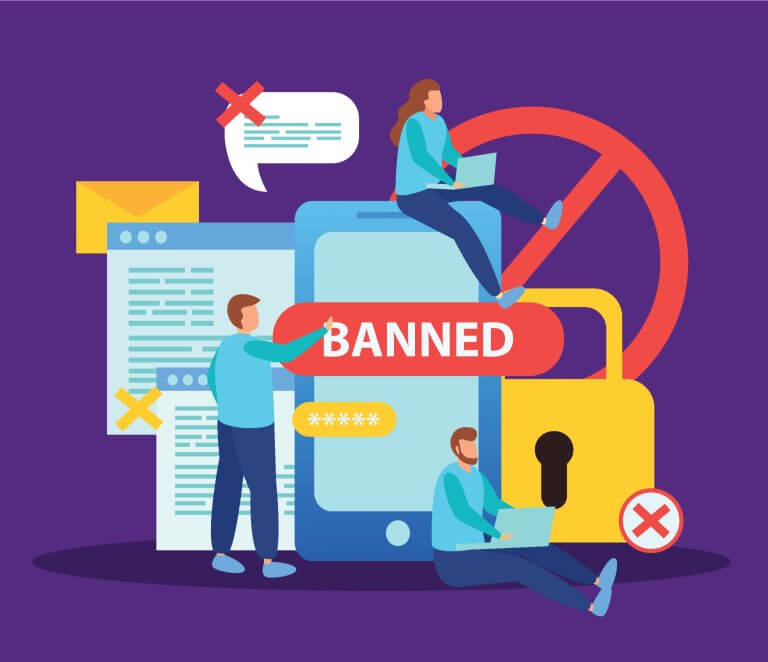Want a heads up when a new story drops? Subscribe here.
Brands, small businesses, and big organizations have different objectives, selling propositions, and values. Yet despite all their differences, they all have one goal in common: reaching as many people as possible. Regardless of what you are selling or how you describe your business, you can’t generate, let alone increase, your revenue if people don’t know you exist on the market or don’t trust you enough to buy from you.
And with that same market getting more crowded and overly saturated each day, what you share, how you share it, and how you handle all your marketing endeavors is crucial for your business’s long-term success and endurance.
Earned media is what brands strive for. It offers the type of authenticity that no other media coverage can generate. Boosting customers’ decisions to purchase earned media is a valuable asset for brands to obtain. While some manage to catch on to the earned-media wave and move swiftly through it, doubling and tripling their revenues, others fail miserably, drowning in their attempts to ride it.
So what’s the catch? Earned media is not easy to get. In fact, it is probably the toughest type of media coverage a brand could obtain, as it requires a great set of marketing skills to do it right. Don’t be too quick to give up your earned media efforts yet.
Albeit challenging, getting beneficial earned media for your business is not mission impossible, especially if you know on which side bread is buttered. The following guide can turn into one of your favorite tools as it will spill out the most efficient tips on how to get your business some earned media coverage.
Time to dig in! Are you ready?

Table of Contents
Different Types of Media
First, let’s get our facts straight. How many media types exist, and what do they represent? Digital marketing experts differentiate three main types of media coverage – paid, earned, and owned media. Thanks to the benefits that go with each media type, they all contribute to a brand’s growth and popularity.
Owned Media
Each type of content you produce, post, and share to your website, social media accounts, blogs, etc., falls under ‘owned media.’ From pictures, blog articles, explainer videos, or graphics to newsletters, e-books, and social media copies, you (supposedly) own that content and use it to leverage your business.
Owned media gives you absolute control over what content goes live on your website and other social media assets. That control is both a blessing and a curse. A blessing because your brand presentation is all in your hands and a curse for the very same reason.
Customers are often wary of brands that seem too perfect to be true. Presenting your brand as such through the owned content you share might make you look shady in the eyes of your audience. Hence, as a brand, you should be cautious of the content you put out there for the world to see.
And if you think that you can go without owned content. Let us break that illusion for you right here and now. No brand can exist without owned media that tells more about the products and services of the business or provides and educates the audience with valuable information. You make no exception.
Before you get earned media, you need quality and trustworthy owned media to engage the audience. Carefully handle what you post, how you post, and more importantly, be as active as possible. You don’t want your existing audience to wear thin. Regular maintenance of your owned media is what keeps it efficient.
Paid Media
Unlike owned media, which is free and limited in terms of reach, paid media offers a variety of possibilities to get to new people for a price. Simply put, paid media is the fancy name marketing experts have given to good old advertising. Numerous variables, such as where, what, and how you advertise, will affect how much you pay.
Any promotional time and space you pay for counts as paid media. With that said, paid media can take many shapes and forms – your sponsored social media posts, online ads, search engine marketing ads, video ads campaigns, etc. And that is not limited just to the digital world. Any kind of offline ad also falls under the paid media category. Television and radio ads might be the primary examples, but print ads, such as posters, flyers, and billboards, are also popular.
Relying on paid media is inevitable. All brands need to advertise themselves at some point. They all need to raise brand awareness or reach new people. And while paid media gives them control over how to handle those goals, it comes with one great downside: people don’t trust ads as much as they once used to.

No wonder ad-blocking extensions and apps are emerging now more than ever. People are doing their best to avoid exposure to advertisements. According to Search Engine Land, 70% to 80% of users overlook paid advertisements on Google SERP and open only ad-free results. And that’s just one example.
Despite all that, paid advertising is not going anywhere anytime soon. There are far too many finances involved in the process, and regardless of the general public opinion, paid media can generate leads or increase revenues when done right. However, there’s a better, more organic way to reach new customers …
Earned Media
Being something like the ambrosia of digital marketing, earned media is one of the highest rewards for brands. If actors are working for Oscars, singers for Grammys, and scientists for Nobel Prizes, brands put all their efforts into creating quality earned media.
Getting other people to notice your brand and associate with it so much that they decide to post about it without you having to ask or pay them to do so is priceless. And that’s basically what earned media is—people mentioning your business organically somewhere without getting anything in return.
In a digital world where everything is so easily accessible, brand-consumer trust and positive relationships seem to have become deciding factors for people on whether or not they should proceed to check out and finish their orders. In the United States, 46% of participants in a study responded that they’d rather pay more for a brand they trust than purchase from one they don’t.
And what better way to encourage your relationship with loyal and potential customers than working hard on your earned media?
The Benefits of Earned Media and Why Do You Need It?

But why would one want to spend time building connections and getting any type of earned media for their brand? Earned media comes with plenty of benefits for brands. And while we scratch the surface, barely mentioning some, it’s time to dig deeper into why this type of media rocks:
Earned Media for Brand Building and Higher Customer Trust
First things first – brand building. Yes, brand building is a complex process that is in no way limited to getting earned media. It involves a complex set of marketing tools, skills, and techniques that combined alleviate the procedure of creating a brand image customers would love, appreciate, follow and support.
How would earned media help you with your brand building? Trust is the foundation of any successful brand. Imagine brand building was like building a home. Your social management skills are your walls, design and brand visions are your furniture and wall colors, content skills are your floors, and SEO skills are the roof.
It all sounds great in theory, but would it work? Would the house be a steady, unbreakable one? No. It will miss one key element to hold it all together. Glue, cement, or whatever else you want to call it, customer trust is the missing element that makes it all work.
With customers wanting to see authenticity in the brands they follow, they now appreciate other people’s honest reviews, shares, and comments more than ever before. With that in mind, getting your brand and its content constantly reshared by other people just because it’s good allows you to connect on an even deeper level with your followers and their own followers.

Brand Recognition
Furthermore, earned media helps and accelerates the brand recognition process. Just think of all the big names on the market that you could constantly recognize by simply seeing their logo, slogans, or other prominent brand elements. The more people share your brand, the more familiar it becomes to others.
Familiarity builds a sense of security that your brand is not going anywhere. It’s a constant, untouched by the market’s fluctuations, and they can rely on it whenever they feel like it. We all know the brands behind the half-eaten apple logo or the ‘impossible is nothing‘ slogan. And while the products these corporations are bringing to the market have a tremendous impact on their brand recognition, a great part of it has come from other people sharing content about them.
Better Reach
Businesses pay hundreds of dollars yearly to reach a larger group of people who will either try to avoid seeing the ads or completely ignore them even if they see them. As mentioned, mastering the art of PPC marketing is no easy task.
However, there’s an easier way to reach new potential audiences through earned media. Any time people share your brand in any way, their friends, family, and followers are the first to see what they have to say about you. With the content reaching new potential customers, it’s only a matter of time before those new people will visit your pages, start following you, and become customers.
Social Proof
Nowadays, no one buys anything before conducting thorough research first. People need information about the product, how it works, how long it takes to be delivered, what packaging it comes in, return policies, and so forth.
Seeing other customers’ opinions about a brand’s product or service is the social proof people might need to convince themselves that the hype is worth it and is real.
88% of consumers trust user reviews from people they don’t know as much as personal recommendations. With that in mind, your earned media can serve as social proof for new potential customers, generating more sales and revenues your way.

Increased Credibility
Guess what comes when earned media and social proof combine? That’s right – credibility. It is a truth universally acknowledged that people often associate paid advertisements with false narratives.
To the majority of people, ads are unreal and untrustworthy as they don’t show the “true value” of the product advertised. With money being the primary component of paid media, many people associate ads with what companies want their products to be, but not as what they are.
On the other hand, customers’ opinions are considered honest and realistic, as they shed light on all aspects of a product, whether good or bad.
Suppose two brands offer similar products. One has a good amount of earned media behind its back, while the other has nothing of the sort. A customer in need of the exact product these two brands are offering appears. Which brand will they purchase from, and what will be the deciding factor for that?
Exactly. The customer will purchase from the brand that’s gained earned media to back up its products. The reason? It appears more credible in the eyes of the average consumer.
Better Marketing Channels Traffic
Another crucial benefit people often dismiss when talking about earned media is the increase in your website traffic. That’s right, generating more buzz toward your business through earned media causes growth in your website traffic metrics.
With more people reaching the shared content and learning about your brand, a new Google search is sure to follow. After all, research is our natural response to everything new in our lives.
Visiting your website or any of your social media accounts on Facebook, Instagram, Twitter or YouTube can lead to an even bigger reward for your business – conversions. Once people hear good things about your business, they get intrigued. They will then visit all your marketing channels, and finally, they get hooked enough to purchase.
🔥 Tip: Hundreds of growing businesses use Socialfix to build their earned media strategy and showcase their products and services. 
Earned Media in Different Channels
Now that we’ve stressed why working on getting more earned media is crucial, let’s move forward and see what this media type looks like across different marketing channels and platforms.

Review Sites
Generally, people love sharing their overall experiences with brands. How good was their customer service? Did they receive kind, polite answers to their questions, or were they given the silent treatment? How did they feel when they opened their package? Did it meet their expectations?
Luckily for them, there’s always someone that would love to read about their thoughts. Customers crave good old thorough reviews. That’s why review sites exist, and are not going anywhere.
It doesn’t matter what they have to buy or book, people love spending a lot of time on review sites, taking into account other people’s opinions, thoughts, and experiences with different brands.
Despite all that, it remains a mystery how many reviews it would take someone to feel ready to go to the next step, regardless of what that step would be. However, according to a survey, the average consumer needs to go through 10 reviews before moving forward with a purchase.
With reviews, you don’t have any control over what’s written about you. However, depending on where that review is posted – your in-house review opportunities like social media accounts and your website page or external review websites – you might get a say in how you respond to those reviews.
Unfortunately, negative reviews are part of the game. Sooner or later, there comes a time when all businesses need to deal with them. Handling negative customer reviews with finesse is crucial for your brand’s reputation.
The 101 rule for every successful review management strategy is taking all reviews seriously. Express your appreciation and admiration whenever a positive review comes your way. Be understanding and check why people might not be satisfied with your product or service. If you can’t change their opinion, let their negative reviews serve as a lesson to improve and become better.

Trade Shows and Publications
Participating in trade shows presents perfect opportunities for offline networking. Industry trade shows gather fellow like-minded brands, bloggers, influencers, and industry experts in one place so that they can communicate, exchange knowledge and ideas and secure some effective earned media.
These events are famous for the real-time social media coverage brands get from all the attendees. With those events, using unique hashtags to compile the highlights of the day in one place for all to see is a norm rather than an exception.
What better way to get some social media mentions for your brand while giving some for other brands you admire and are proud to be in one industry with at the same time?
The best thing about these types of events is that the earned media opportunities are not limited only to social media mentions throughout the day. Often such events are organized by an event marketing agency, so afterward, you can see lots of social media posts, wrap-up blog articles, or YouTube videos explaining the gist of the event, giving shoutouts to those involved.
And it’s not just the event organizers that do it. Influencers, bloggers, journalists, and other guests post a summary of the event. So who knows, you might have even more opportunities for free mentions than you initially anticipated when you signed up for your first industry conference.

Social Media Shoutouts
Social media mentions and shoutouts are an increasingly popular way of generating more earned media. Social media is on the rise, and its significance and importance for brands and consumers will only grow stronger in the foreseeable future.
With that in mind, one way people express their feelings for a brand or product is through social media. People love creating photos of the coffee they’ve had this morning, the dinner they ate at that new fancy place in town, or the clothes they have recently bought from that online boutique their favorite influencer recommended. And when they post about all that, they usually tag the brands as well, generating content for them.
Even if they are not too much into posting, stories and resharing are always an option to express admiration, gratitude, or disappointment. Shoutouts are so cool that even celebrities do them all the time. For instance, Blake Lively never misses a chance to express her love for Michael Kors. While some share their appreciation for companies they work with and fellow celebs, others, like Selena Gomez, use shoutouts to promote their personal brands.
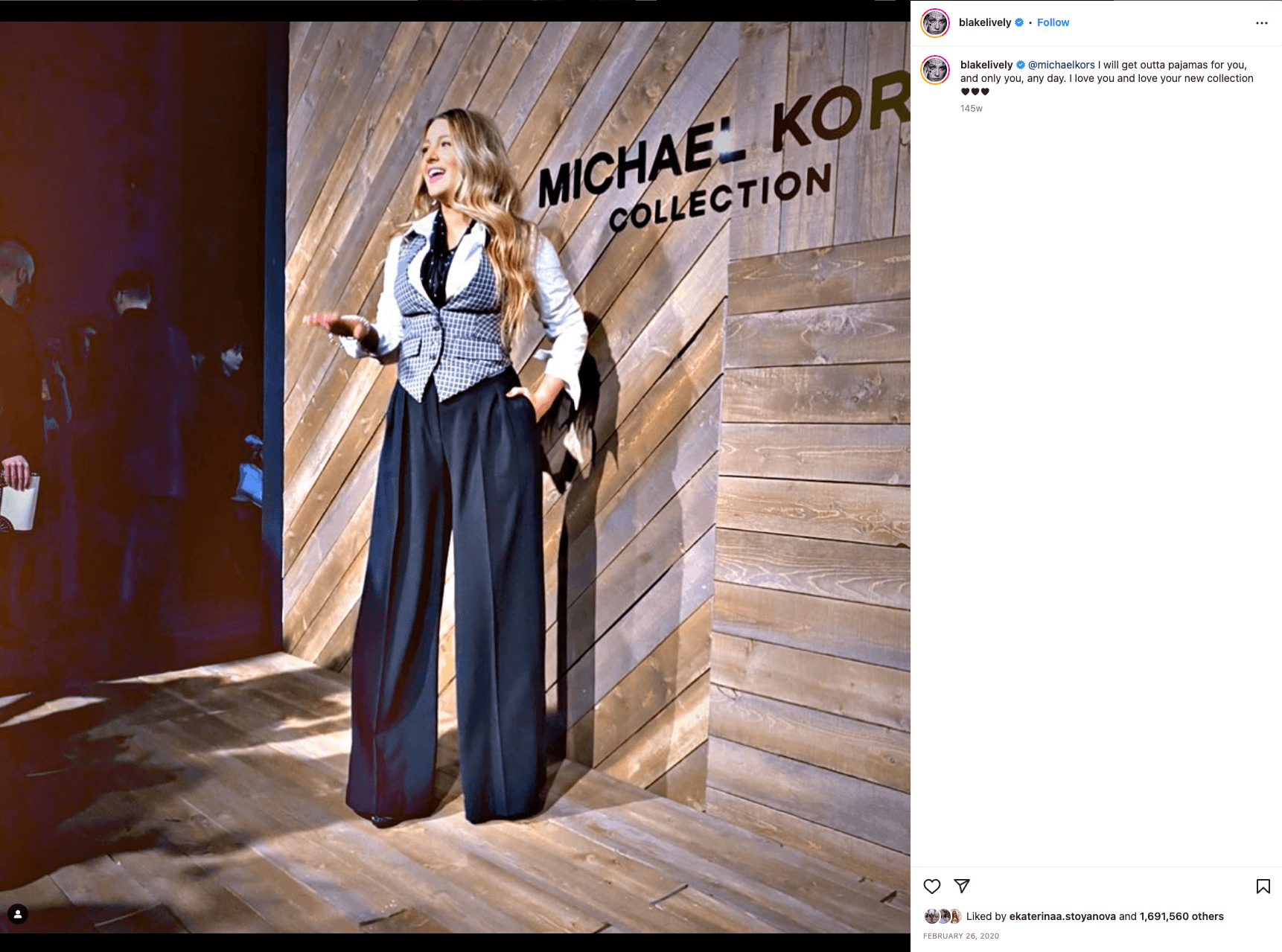

But let’s go back to the normal world. The one where A-list celebrities don’t post about small businesses or brands, trying to secure more earned media. Small brands with immaculate social media marketing strategies have learned to take advantage of shoutouts in their own way and turn them into campaigns to raise extra awareness, boost engagement metrics, and generate even more sales. But how? The answer you are looking for is user-generated content. Keep reading to find out what that is and how it helps with earned media.

TV Segments
The world hasn’t gone all digital yet. Traditional TV is still a thing, and a creative way to get some earned media out of it is by appearing in a TV program or segment. Now keep in mind we don’t refer to the advertisement and commercial spots that people tend to skip forward. No.
Guest starring on a local or national show in your industry is a form of earned media. TV shows are always looking for new faces to freshen up their programs. And where do they find those people? Personal recommendations are valid suggestions, but most often than not, social media is the correct answer.
Don’t get us wrong! There are not whole teams of people constantly devouring social media platforms looking for the next big brand or person to invite on the shows. Yet, in this business, they are always aware of what’s going on in the digital world.
With that in mind, brands, people, and businesses that stand out and are eager to make a difference in the status quo often get invited to raise awareness and speak publicly about what they do.
And guest starring on shows is not the only way to secure earned media from TV. Sometimes brands that catch the attention of the journalists in the news teams appear on their local (or national) news stations.
Although this type of earned media is quite traditional and some would even say old-fashioned, it works. People haven’t abandoned TVs completely, so it’s still an authentic way to raise awareness for a business.
Magazine Features
TV is not the only form of offline earned media. An additional method for businesses to obtain earned exposure is through magazine features. And once more, it occurs as a result of a company’s favorable brand perception on social media.
Magazine features often happen in the form of interviews. For instance, a journalist might contact a brand to ask and join them for a day to write about how the said brand creates its product. Or brands may be contacted as industry experts to weigh their opinions on different matters.
Other times brands might not even be aware that they will get a feature in a magazine. For instance, someone is writing an article about Christmas gift ideas for a mother-in-law. The journalist has made a list of ideas, and voilà – brands get free mentions.

The Challenges of Building Solid Earned Media
Earned media is a precious asset that helps build trust and credibility and boosts customer-brand relationships. However, why is it so difficult for many brands to cultivate it?
Earned Media Takes Time
Reaping the fruits of what you sow takes time. And the same applies to earned media. Building relationships with media, influencers, and regular customers is not something that happens overnight.
But that’s not all. What takes even more time is building a brand that is worth sharing. Creating a community that appreciates the content a particular brand creates, understands its values, and embraces all its endeavors. It all takes time. But it is worth it. Think of it as a rewarding investment that will pay off when you least expect it.
Lack of Control Over What’s Shared
One of the main challenges that make earned media so difficult to obtain is the lack of control brands have over it. But to what extent is that true?
Yes, brands don’t have any say as to who covers what. They are basically at the mercy of customers, influencers, and media in general.
Given this, brands have the power to create a favorable brand image. Growing responsibly, offering quality products, responding quickly to customer inquiries, posting valuable content – all of that is up to brands. If brands are taking care responsibly of all that, then the earned media they receive should be predominantly positive. However, …
Not All Coverage Will Be Positive
With earned media, there are always risks. What if a brand goes viral for the wrong reasons? Or mistreats even one customer? People are free to share whatever they want on their platforms, and they won’t hesitate to express dissatisfaction or disappointment.

Cooking up an Earned Media Strategy that Works
Earned media is a gold mine. But as with anything else, one gotta work hard to discover it. Waiting around for people to start randomly sharing posts and reviews about your business won’t do you any good. So get it all in your hands and start building a better brand. Here’s what you should do:
Cutting-Edge Design to Catch the Eye
Beauty may be in the eye of the beholder, but attractive design can help you catch their eyes faster.
Don’t shy away from getting the website of your dreams. Maybe you want your website to captivate with outstanding scrolling experiences or prefer a muted, nude color palette because your brand is the epitome of minimalism.
It doesn’t matter if you will follow popular web design trends or come up with some design breakthroughs. As long as what you do corresponds with your brand personality and everything you want it to represent, don’t hesitate to go for it.
Why Is Design Important in Earned Media?
Before they lay eyes on anything else, new visitors will first see the visuals on your social media and the graphic design choices on your website (animations, charts, videos – all of it). And trust us, you don’t have much time to convince them to stay and learn more about you. To be precise, you only have 0.05 seconds before they leave, so make them worthwhile.
Furthermore, people have now started to develop an eye for aesthetics. And are more likely to reshare content that they believe is in line with said aesthetic.
With that in mind, your visual brand identity has the potential to attract like-minded followers. Hence, when choosing your color palettes, typeface, and anything design-related for your brand, think of your target audience.
For instance, if your ideal clients follow brands that use vibrant, popping colors, it’s a good idea to jump on the trend and pick a similar carefully chosen palette that will point their attention to you.
And here’s an example. Sugarpova is an all-sweets brand created by no other than Maria Sharapova – one of the best tennis players of our time. A quick scroll through the brand’s Instagram page shows us that it has a thing for vibrancy and upbeat design, picking hot pink, lemon yellow, and orange as its primary colors.

And obviously, customers love that. The brand has generated lots of earned media, with consumers sharing pictures of the candies in various locations globally. Talk about a job well done.


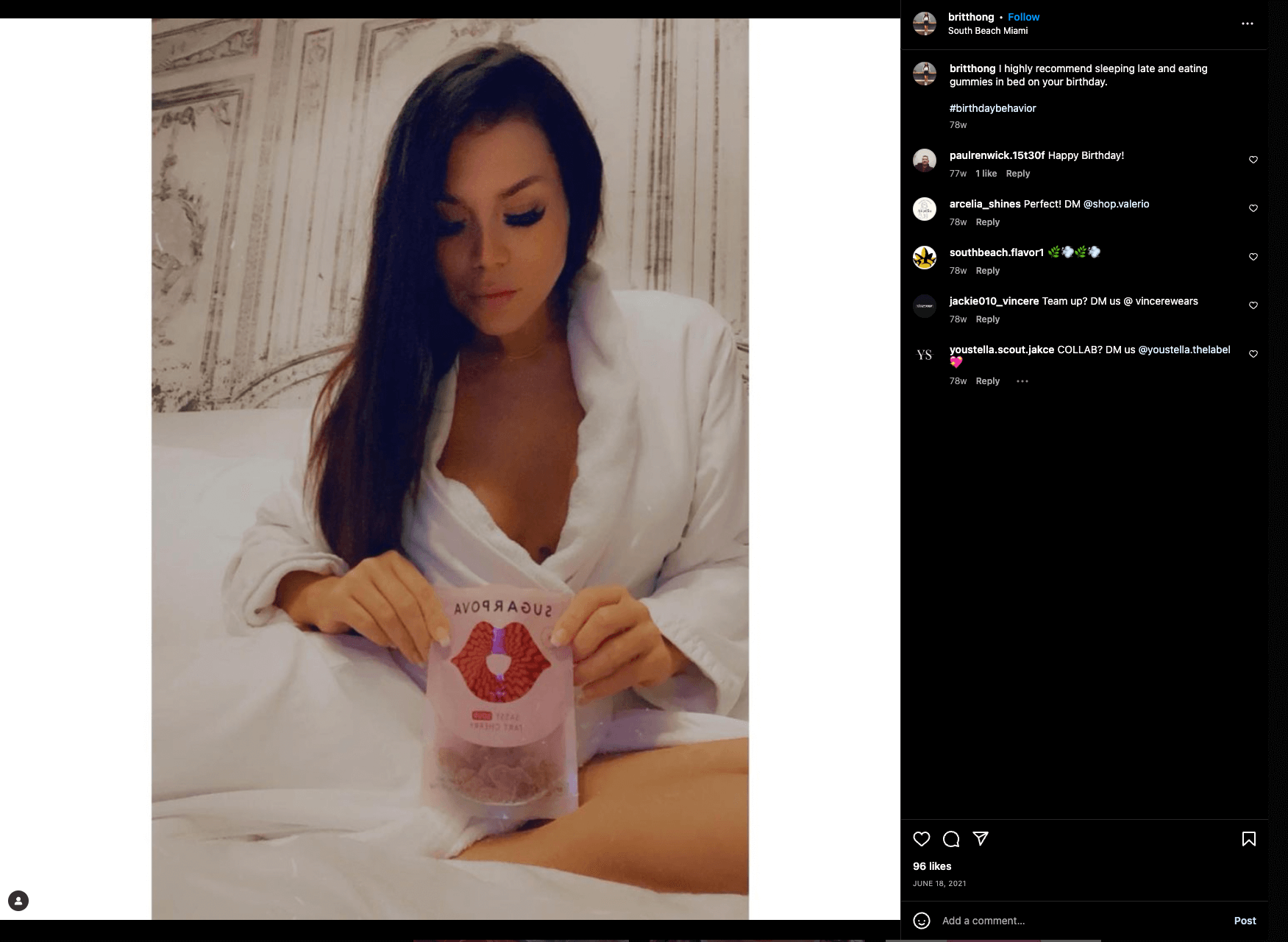
Work Your Way up the SERP
Making your business website easily findable is the next thing you should focus on. With over 1.5 billion available websites in the search engines, it is no longer a sea but an ocean full of businesses, all fighting to stay on the surface. So how would anyone buy from you and share about your business if they can’t find you?
It is simple. Businesses either learn how to swim and appear in the top places of SERP, or they drown. Learning how to swim and stay on the surface is by no means easy. And that’s where SEO comes in handy.
SEO, which stands for Search Engine Optimization, is the tool marketing experts use to rank websites higher on Google (and other search engines).
Higher rankings = better visibility.
And isn’t that what you want for your business? For people to easily access your website, find valuable information, make a purchase or book a service and share it with others who will later do the same?
SEO Basics To Start With
The first and most prominent rule about SEO marketing is that it doesn’t happen overnight. Like all good things – it takes time. So don’t expect that you will modify something here, change something there, and you will suddenly appear on the top results of the first page. No, it doesn’t work like that. Taking a holistic approach to your marketing strategy is the best tactic.

1. Perform Keyword Research
You need quality content that attracts the audience, but you also need to make it in a way that would make Google think it’s going to help even more people.
The right way to show Google that other people would love your content because it will give them valuable information on X and Y topics is through keywords.
When someone is looking for any information on the web, they type a bunch of words that best describe their search intent. Those phrases are what marketing experts call keywords. The more people use the same group of words when searching for a particular thing, the more volume the keywords have.
Keywords allow the search engine to distinguish one search intent from another.
To determine what words a brand needs to use to make its content findable, they need to perform keyword research.
We will discuss content in a bit, but let’s say it right here and now: It is vital that all your content is SEO-friendly! It doesn’t matter how good your website content or blog articles are if no one can find them. Even if they contain original, valuable and intriguing information, writing them would be pointless should they not have relevant keywords to help Google rank them.
2. Optimize Metadata
Page titles, meta descriptions, and general metadata are among the first things visitors notice about your website.
Your metadata should be unique and focus on your brand proposition. It also should include your primary keyword to help with ranking.
With metadata, it is significant that you follow the character guidelines:
- Meta titles – should be between 50-60 characters.
- Meta descriptions – should be no longer than 160 characters. It is best to include a call-to-action, but it shouldn’t sound too salesy.
3. Website Architecture
Keeping everything neatly organized is a surefire way to keep visitors happy and search engine crawlers satisfied. Website architecture refers to how you’ve organized the information on a website.
Pages hierarchy can impact how various content ranks on the search engine. When establishing your website architecture, focus on navigation, URLs, sitemaps, and breadcrumbs.
Internal links are a spectacular way to support a website’s architecture and build credibility for the pages linked.
4. Think Mobile
62.06% of website traffic comes from mobile devices. Let that sink in. In our fast-pacing world, people no longer have the time to perform all their search requests on computers.
As a matter of fact, more and more people will rely on their phones for information in the upcoming years, and that number will only grow stronger. Given all that, brands need to keep their websites mobile-friendly.
No matter how interactive your website design is or how engaging your content is, if your website takes too long to load or doesn’t work well on mobile, people will press the X button in the blink of an eye. You won’t get the earned media you’ve hoped for, but you might get a negative review that could hinder everything you’ve worked for so far.
Hence, always think about mobile first. With mobile, loading speed is essential, so ensure your website is lightweight enough to load fast on different mobile devices. Run lots of tests and perform regular checks to ensure everything is going smoothly and people have no trouble reaching your website on their mobiles.

Content is King, Use It Wisely
Now that you’ve caught attention with captivating, cutting-edge design, it is time to give the audience something more – compelling content worth sharing.
What Makes Owned Media Shareable?
Cultivating an impeccable content marketing strategy is crucial for the growth of your business. After all, it is much easier for others to share your social media posts, blog articles, etc. if they find value in them.
By providing value, we don’t necessarily mean that all of your content should be educational at all times. On the contrary, memes rule the Internet. So showing a sense of humor now and then is an excellent way to produce shareable content for the followers. In fact, not only is meme content more shareable, but it is also more likely to bring some new conversions for brands.
After all, more than 60% of people report that they are more likely to buy from meme-friendly companies that occasionally make people laugh with the content that is part of their marketing strategies.
Totino’s – the CEO of pizza rolls – according to its Instagram bio, is a brand that’s well aware of this statistic. With one of the strongest meme games we’ve seen from a brand, Totino’s the perfect example of securing earned media with content that makes thousands of people smile.


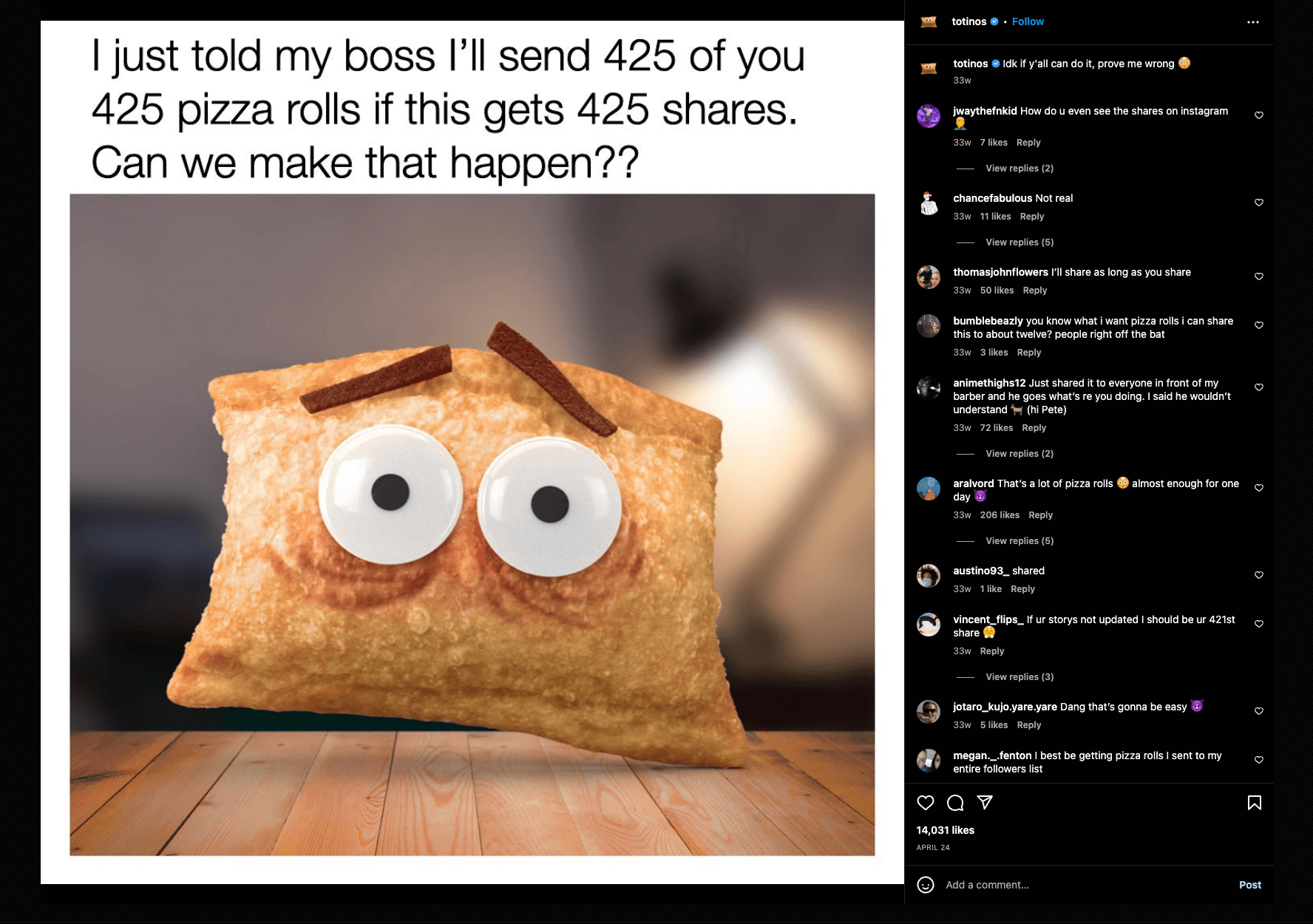
While some brands use laughter to generate reshares, others take a different, more inspirational approach. Some brands, especially those focusing on personal growth, are all about motivating their followers.
Success stories, motivational quotes from celebrities, book authors, and athletes that empower readers, or actionable tips on how the products can help achieve more are a few content examples that are surefire ways to obtain earned media.
If we ask you to think of one such brand, would Nike be the first thing that comes to mind? Most likely, yes. People enjoy sharing Nike’s social media content, whether it’s to inspire their own followers or to make themselves feel better.


5 Tips for Creating Shareable Content
A lot goes into content marketing, and sometimes it may feel overwhelming. Here are some tips to help you create quality content people would love and gladly share, securing the earned media coverage you desire.
1. Understand Your Audience
No content will be good enough if you don’t know who you are creating it for. Therefore, it’s important to know and understand your audience. Analyze its behavior to gain insights into what type of content they like.
Depending on your industry niche and business, people might prefer one content type over another. That is how you will know whether your audience craves educational, motivational, or more entertaining content. Of course, even if your audience likes to devour informative articles or videos, it doesn’t mean it would like to have a good laugh every once in a while.
2. Make a Earned Media Content Plan
Researching your audience well enough will also tell you how often they would like you to post and do they prefer blog posts over videos or stories over reels.
Knowing all that, you can finally create an actionable content plan. Begin with a monthly schedule that comprises of:
- the number of posts
- the content formats – blog articles, stories, social media posts, reels, etc.
- the type of content – informational, inspirational, entertaining
- posting times and locations – when and where you will post
- additional guidelines
3. Produce the Content
No matter what content you are producing, thorough research is an essential element you can’t go without.
The more content you produce, the better understanding you will have of what takes you the longest. If you are a beginner, here’s what you should consider for every content type:
- Social media posts – They need engaging copy that would make viewers like or comment on them. People usually don’t like to spend too much time on texts when scrolling on their social media platforms, so keep your copies short, sweet, and straight to the point. Your posts also need a creative visual to attract the viewers’ attention. A photograph or an engaging design graphic should always adhere to your brand playbook.
- Stories – Determine if your stories will be short videos or photos with text on them, and plan when you will record them. After its latest update, Instagram now allows uninterrupted video clip stories of up to one minute instead of only 15 seconds.
- Blog posts – Requiring lots of research and creative thought, blog posts usually take a lot of time to be completed. To make the most of a blog post, make it SEO-friendly, by including relevant keywords to help you rank it higher on Google. Make the blog posts as informational as possible and appropriate to your products and services.
- Videos – Similar to blog posts, videos, regardless of their type, take a lot of time to execute. Video marketing can’t be explained in two sentences. Yet, when creating videos, make scripts highlighting the most fundamental aspects of what you are covering. Always edit your videos with your brand guidelines in mind. And if you don’t have time for any of that, a video production team could be of help.

4. Repurpose Content
Creating fresh content every month is essential. However, every so often, brands have the luxury of repurposing old content. For instance, if you have a podcast (as you should), you could take an episode, select a valuable highlight from it, create a stunning visual or photo to go with it, and post it on your social media to invite your follower to go and listen to it.
Don’t let our one example scare you. It is just one of many. But we get it. Managing a successful podcast from start to finish and reusing its content might be tricky, challenging, and time-consuming. Luckily, a podcast marketing agency is always ready to lend you a hand.
Content repurposing is a terrific way to freshen up your social media pages or your website without having to create an entirely new piece of content from scratch.
It gives brands peace of mind when they feel like they don’t have anything to post. And don’t be scared that people wouldn’t share your repurposed content. As long as it is good and gives them value, you are safe.
5. User-Generated Content (UGC)
Some would argue that user-generated content doesn’t exactly count as earned media. However, in reality, it is. Even if brands sometimes have to ask for it.
UGC campaigns are not that difficult to execute, yet, there are UGC rookie mistakes some new brands might make. The most prominent one is failing to define ground rules for creators to follow.
Why does UGC work, you may ask? If people are willing to share a brand’s content without getting anything in return, why wouldn’t they participate in a UGC campaign where they might get a free mention or a reward even in the end?
The Ultimate Challenge of Content Creation
The problem with creating any quality content is that it takes time. And with time being so precious and limited, many brands can’t keep up. Struggling to execute their content plans, brand owners feel like they’ve entered a dark tunnel. Yet, like at the end of any tunnel, there’s light. And that’s a digital marketing agency coming to the rescue.

Turn Customers into Fans
The hardest thing about obtaining earned media is that you should focus on all these different points, aspects, and marketing strategies all at once. Your SEO and content marketing efforts should always go hand in hand, but the same applies to your design and content strategies. It is all heavily intertwined, and you can’t do one thing without the other.
To top it all, while taking care of your design, content, and ranking position, you should also gain your customers’ and potential audiences’ trust. Because let’s face it, all your marketing efforts will be in vain if you don’t cultivate a positive relationship with the people that follow your brand.
The more people feel like they can trust your brand, the more loyal they will feel toward it. With that in mind, here are our two cents and two tips on building brand loyalty:
1. Keep Your Social Media Active
You can’t exist in today’s market world without being continuously active on social media. If you rarely post, comment, and reply to DM requests, people will consider you shady, and undoubtedly, your relationship won’t last long. Why would people engage with you if you are not there for them to ease their pain with your products and answer all their questions?
You have the accounts, the content, and the posts. You might as well stay active for another hour and interact with your audience:
- If they have commented on your posts, give them a reply.
- If they have tagged your brand on their story, repost it and thank them by giving them a shoutout.
- If they have made an effort to ask you a question, take a minute to get back and answer it.
- If many people ask you the same thing, make an explanation story or post. If many different people don’t understand something about your brand, you might not have explained it well enough.
- If other brand pages have interacted with your content, return the favor, you never know if that’s not a potential collaboration in the making.
There’s so much that you could do to maintain a positive brand image across social media. Don’t think that posting your scheduled content will be enough. No, it’s just the first step.
Attitude is what wins people over and has the power to secure you some well-deserved earned media.

2. Make Your Audience Feel Special
Ever heard of brand archetypes and, more specifically, the Magician? The Magician is a brand personality existing to make the audiences feel special, unique, and loved. Always outdoing themselves by providing exceptional experiences for those following and purchasing from them, Magician brands manage to create valuable communities that support, educate and empower.
With that in mind, even if your brand is not really a Magician by heart, there’s a lesson or two you can learn from this group of businesses. Pamper your audience and create a loving community that allows people to thrive with your products.
Take on social media and create a unique hashtag your followers can add to their posts, stories, tweets, etc. People love feeling like they belong to something greater – almost like a family. Use that and think of an engaging hashtag to show them that they belong with your brand.
#ShareACoke is a hashtag campaign that feels like it’s been around for ages, yet it still generates buzz across all of Coca-Cola‘s social media platforms.

Lay’s #DoUsAFlavor campaign is a suitable example of a brand generating some earned media coverage by making its audience feel involved. The brand asked customers to promote the next best Lay’s chips flavor. The campaign was more of a competition as the winner was promised a reward of $1 million and reached thousands of people.
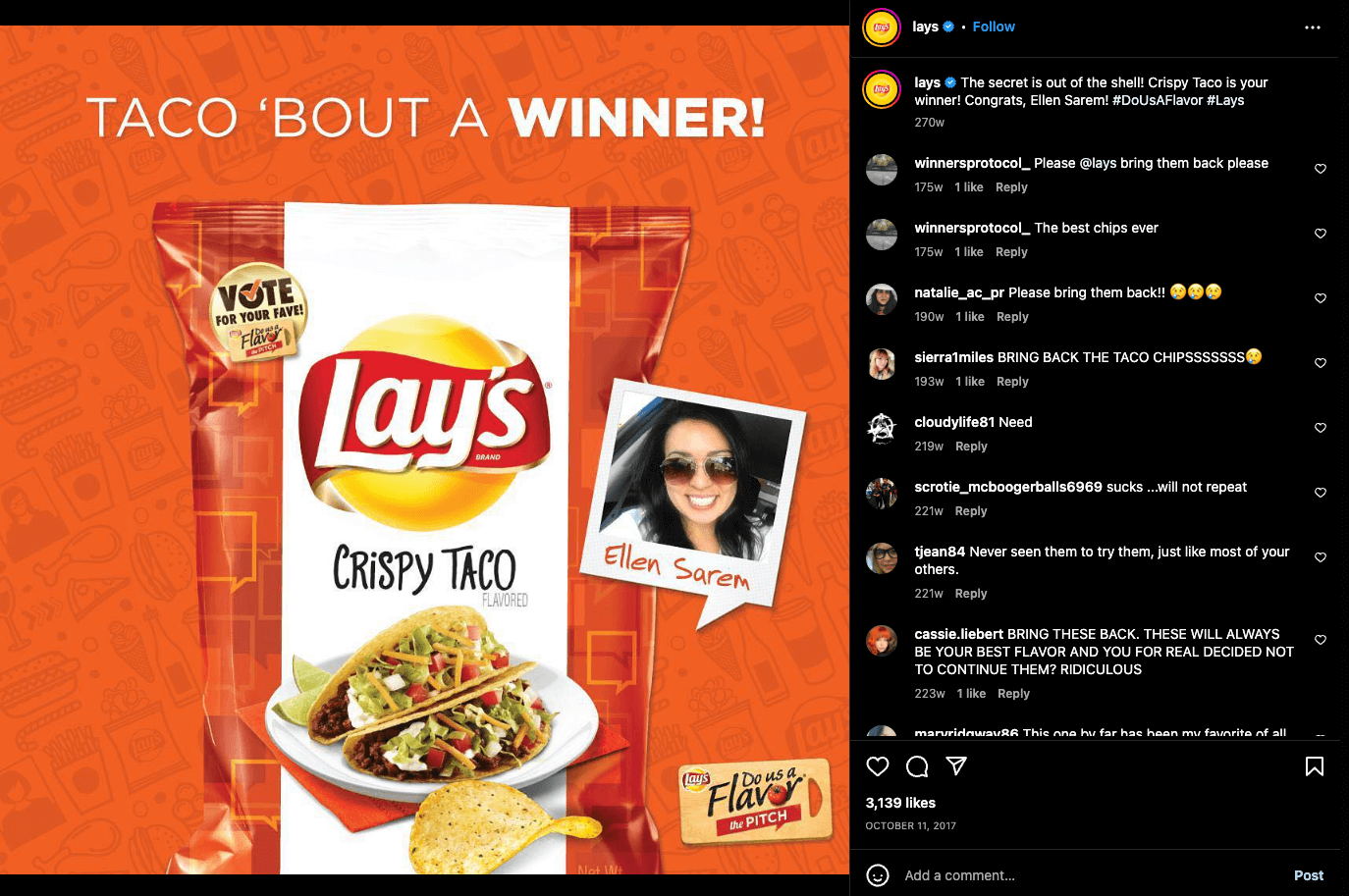
Tested Methods for Generating Earned Media
Now let us go through some more tricks you could do to generate more earned media for your business.
Guest Posting
If you are an industry expert and want to proudly represent your business by spreading your knowledge to a new audience, guest blogging is a good way to start.
Why is guest blogging awesome?
- It enables you to reach new potential customers.
- It gives your external link-building strategy the necessary momentum to boost your credibility and ranking positions even further.
- It builds your relationship with other businesses from your niche.
Guest posting is usually a two-way street and is beneficial for both parties, meaning you will also have to allow guest posts on your blog.
How to Start With Guest Posting?
It all starts with a simple search. Before jumping on the guest blogging wagon, you should do your research first.
First and foremost, know your target. You only want to post your content on websites in a similar niche as your business. Otherwise, you risk losing your credibility. For instance, if you are running a fintech business, you probably wouldn’t want to appear on an influencer’s outfit-of-the-day blog.
Concentrate your search on discovering sector-specific, non-competitive blogs where readers would be happy to distribute your knowledge, thoughts, and information.
The web is flooded with spammy websites no one actually visits or reads. Make sure you avoid posting on such and don’t ever post spammy content on your own blog.
Most websites offering guest posting have their own guidelines explaining what kind of guest content they want, preferred word count, the number of (do-follow) links allowed, tone of voice, etc. Before writing, let alone submitting, your content, ensure it meets their expectations.
Pro Tip: Never submit plagiarized content! And don’t upload plagiarized text on your blog! Not only will your content be removed, but you will lose customers’ trust and loyalty in the process.

Guest Posting 101: 5 Tips for Beginners
Here are a few tips when it comes to guest posting to have in mind.
1. Articles Should Focus On Education, Not Promotion
We all want to link to our products or services all the time. Unfortunately, that won’t work. Readers don’t like sharing overly promotional texts that look like they are part of a TV commercial section slot. They want to share valuable pieces that educate and inform on topics that intrigue them.
Furthermore, other websites might not even post your content if it is too salesy or overly promotional, especially if it goes against their guest posting guidelines.
Instead, use your guest posting opportunities to prove yourself or your brand as an expert in your industry. One that people would like to work with or purchase from.
2. Write An Author Bio
Author bios are the best way to introduce yourself and your business to the readers. That’s where you can say a few words about what you do and your company’s values and missions. Considering many websites wouldn’t allow do-follow links back to your business in the main body of your content, you could always include those in your bio.
3. Add Internal Links To The Article
It doesn’t matter what or who you are writing for, don’t miss your chance to include at least one internal link to the company’s previous blog posts, even if they haven’t particularly requested it in their guidelines.
Trust us, they will appreciate it. That might be a small act of kindness that improves their SEO, but it also shows that you’ve taken the time to conduct research.
4. Finish With A Call-To-Action Appeal
While writing your wrapping paragraphs, think about something you can ask the readers. Ask for their opinions on the topic or whatever you believe might interest them to leave a reply.
5. Express Your Gratitude On Social Media
Once your guest blog post is live, share it on your brand’s social media platforms. Yes, that would drive new people to the other company’s platform, but it would also show your followers that you are a credible source of information that offers valuable answers.
HARO Requests
Want to appear even more professional and trustworthy? Then you should try out HARO. Help a reporter out is a platform that connects journalists to sources.
Imagine you are a journalist writing this big piece on a topic you are unfamiliar with. You need relevant and adequate information, so the best way to get it is by communicating with experts on your matter. HARO helps you do just that.
But how can that get you earned media for your brand? Every day HARO sends an email to registered users with a list of requests from journalists.
People then go through all their requests and introduce themselves to the queries. When they find a question that matches their expertise and they meet all the requirements, they can leave a reply. Later if the journalist finds it helpful, he can use it in his piece by giving credit where it’s due.

How to Get Your Answers Selected?
First and foremost, make sure you are providing factual expertise information. If the journalist wanted to learn something from a blog post on the first page of Google, he would have done it in the beginning. Provide real valuable insight, your experience, or your honest opinion.
Don’t forget to include your credentials with your answer. Write down your social media info, website, and anything else that might prove you are the expert you claim you are.
Use Paid Media to Get Earned Media
One clever way to generate more earned media is through paid media. Bear with us. Influencers. Don’t give us a look. We know how it sounds, but give them a try, as this industry is skyrocketing. In fact, it is so much on the rise that it hasn’t reached its peak yet, and will only grow stronger in the next couple of years. But let’s talk in numbers. By the end of 2022, the market share of this fast-growing industry is to reach $15.2 billion.
So, for better or worse, influencers will continue to be a force to reckon with. With that in mind, you’d better use them to your advantage.
There are hundreds of things to know about influencer marketing before launching your first campaign. Yet, the most important thing right now is understanding how they can generate some earned media.
Influencers are famous for sharing their thoughts, experiences, and opinions on brands, products, and services. People watch and follow them because they trust what they have to say and find value in that information.
With that in mind, it’s safe to assume that influencers have managed to build a positive image of themselves in the minds of their followers. So those same followers are ready to comment, like, and reshare almost anything influencers are posting about.

So if an influencer (that is carefully selected) posts something about your brand, recommends your product, etc., asking their audiences to repost all that, they most certainly will.
How to Secure Earned Media with Influencers?
Giveaways are probably the best way to secure some earned media with influencers. All giveaways have rules participants are required to meet to enter, and almost all of them ask for following or resharing. You can set the rules with the influencer and make sure that they put your brand’s name and credentials in the terms & conditions part of the copy.
Considering that people love competing for free stuff, you can expect that they would love to reshare the content, granting you some earned media in return.
The tricky part is that you might have to pay the influencer for that. Depending on how big your influencer is on social media and how many people interact with their content, you might have to negotiate a deal that suits both sides.
Micro-influencers might agree to collaborate with you in exchange for some freebies or a small sum of money. However, if you want to collaborate with some of the big names out there, that might be costly.
Influencer Marketing 101: How to Choose Influencers
The following points should help you make the right decision when it comes to choosing influencers to work with.
1. Be Careful Not To Get Scammed
With influencer marketing becoming such a popular work perspective, there are now many scammers. Given that, be careful who you trust.
Before making a deal with an influencer, do your research. Having many followers doesn’t necessarily mean that they are real. Always ask them to provide stats on their engagement metrics.

2. Understand The Different Types Of Influencers
Depending on how big their following is, there are usually five types of influencers:
- Nano-Influencers – 1k to 5k followers;
- Micro-Influencers – 5k to 20k followers;
- Mid-tier Influencers – 20k to 100k followers;
- Macro-Influencers – 100k to 1M followers;
- Mega-Influencers – 1M+ followers.
Each influencer group has a set of specifics that best describe their services and contribution. With that in mind, each group has different service pricing ranges.
3. Make A Contract
It is best to have all the requirements, payment details, and all other important information written down in a contract.
Contracts protect all parties, so if an influencer is afraid or unwilling to sign them, there’s probably something off. Be careful!
4. Track Results
Always require your influencer to send insights into how the campaign is going.
- How many people have reshared the content?
- How many have reached out to the influencer, requiring more information, and so forth?
Figure out your goals and measure your success.
Press Releases
Your brand has something exciting to share with the world? You are opening a new office, transferring your location, or simply launching a new product or service?
Don’t do any of that without a press release. Whatever news you might have, press releases can help you reach a much broader audience.
If you’ve already made some connections with PR experts, journalists, or hosts on a local or national level, then you can contact them and ask them to share the good news.
If not, worry not. Reporters are always looking for new things to share, and news usually travels quickly, so it is almost certain that someone will pick up on your press release info and give you a free mention somewhere.

Podcast Pitching
With podcast listeners expected to reach an incredible number of 424.2 million people by the end of 2022, it is safe to say that brands need to get themselves out there.
But how do you get yourself out there? Much like guest appearances on TV shows, you can wait for someone to notice the remarkable things you achieve with your business or reach some podcasts yourself.
While TV guest appearances might be more difficult to land, podcasts are usually more open and inviting. So our advice? Reach out!
Find podcasts you admire and are famous for interviewing businesses that make a difference and positively impact the market. Follow them, see what they usually talk about with their guests, engage with them on social media and when the time comes, jump in their DMs and say “Hello!”
Don’t Forget about Word-of-Mouth Marketing
We spend so much time in our digital bubbles that we often forget that the real world exists and there’s a way to get some organic earned media coverage there.
Word-of-mouth marketing is probably old as time. It’s always been around and seems one of the most efficient ways to generate more buzz for a business and increase its revenues.
With word-of-mouth, barriers don’t exist. You have zero control over what’s being said and how it’s being said. Most importantly, there’s no way you can ask for it.
People either speak about your brand – or they don’t. There’s no in-between. While they can repost a post in their stories without saying a word, they can’t talk halfway with others about your products.

So how do you get people to talk about your business outside of social media and their electronic devices? You either delight them or disappoint them.
So we are back at square one. The key to generating any form of earned media, whether on- or offline, is captivating the audience with your products, services, customer services, social media activity, and overall attitude.
So let’s sum up how all that happens:
- You create a quality product or service that solves people’s problems and gives them the value they haven’t expected.
- You offer outstanding customer service that answers every question and puts the people first.
- You create valuable content people would love to share with their friends, families, and followers.
- You make them love and trust your brand by being your most authentic self.
Tracking and Measuring Earned Media
Tracking and measuring earned media is often impossible. For instance, you never know how many people have screenshotted and reshared your content later. Or how many people your local TV news station has reached with their piece on your business.
Don’t worry, if you suddenly go viral or get a mention in a reputable source, you will be the first to find out. And yet, you can get a rough idea of how you’ve progressed in this regard. So how can you check if your earned media strategies are paying off?

Links
If you are practicing guest posting, make it your monthly goal to check how many websites your content has been featured on.
Create a sheet where you can track your progress. Include any relevant information, including website name, domain authority, contact email, topic, guidelines, publication date, etc.
Social Sharing
On social media, it is easy. You can manually check your metrics for how many people have reshared your content. However, that won’t give you an insight into how many people have reshared your content from them, but at least it gives you an idea of how big you are growing, allowing you to track the process.
If you use any social media tools, they can also generate this information for you, saving you precious time and effort.

Will Earned Media Continue to be Relevant?
Earned media has been around for ages and will continue to be here long after we are all gone. Our point is that people will always need to share their experiences with a brand, especially now that they can make a living out of it.
So people will always talk. So it is your job to make them say nice things about your brand – things can help you reach a wider audience, introduce your services to new people and grow your business organically, thanks to their positive feedback.
Socialfix and Earned Media: Can We Help?
Socialfix specializes in brand building and positioning and offers a holistic approach to cultivating a business’s marketing strategy. Covering design, SEO, content, and video marketing, Socialfix can help make your brand a leader in your industry.
Building your brand from scratch allows our experts to do what’s best for it and make it an unforgettable experience for your customers. One they would feel enticed to share with their followers, family, or friends.
Earned media is a result of a brand well done. And that’s what we excel at.
Final Thoughts
If you think about it, earned media is amazing as it is basically free publicity. Regular people don’t even realize how much they help brands grow by simply resharing their content. And the best part is that they actually like to do it.
They don’t feel obliged to reshare or post feedback comments. They do it out of their inner need to belong and be part of a group.
Nurturing that need is in a brand’s best interest. Because, like it or not, brands need earned media coverage as much as people need to express their opinions freely.
Many brands fear that earned media can negatively impact their growth and won’t have the positive outcome they want. However, that’s certainly not true. Negative reviews or publicity won’t cause permanent harm as long as brands are ready to change for the better.
Be good, share valuable content, offer quality products, be responsive, and your brand will secure the earned coverage it needs.


















